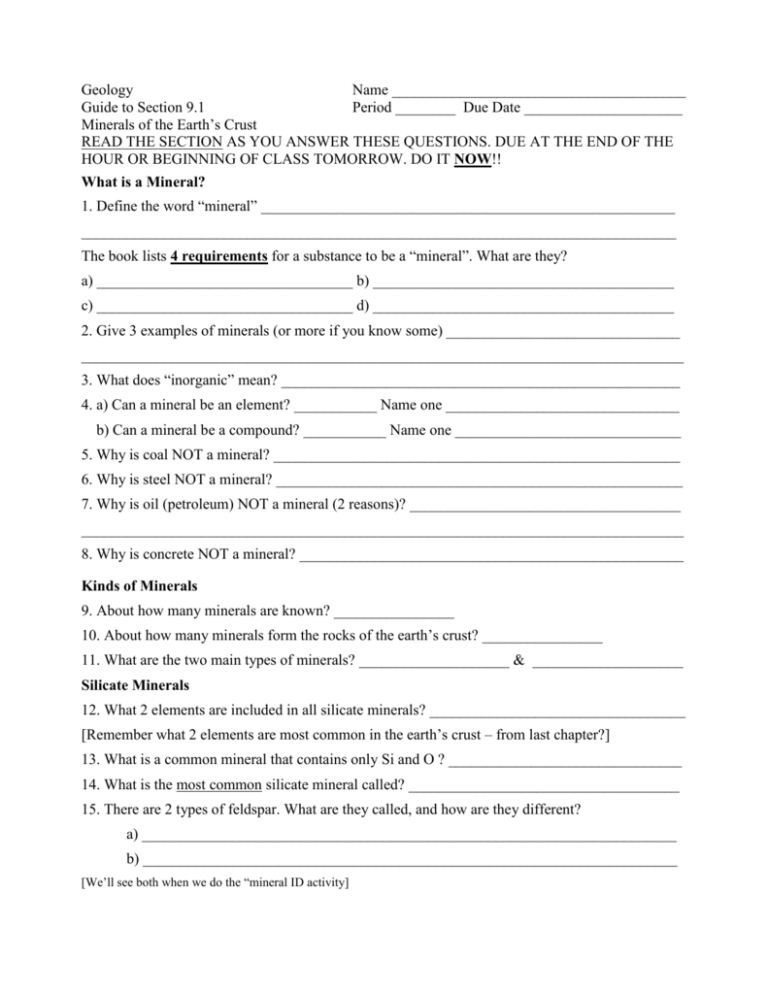What is a Mineral?
advertisement

Geology Name _______________________________________ Guide to Section 9.1 Period ________ Due Date _____________________ Minerals of the Earth’s Crust READ THE SECTION AS YOU ANSWER THESE QUESTIONS. DUE AT THE END OF THE HOUR OR BEGINNING OF CLASS TOMORROW. DO IT NOW!! What is a Mineral? 1. Define the word “mineral” _______________________________________________________ _______________________________________________________________________________ The book lists 4 requirements for a substance to be a “mineral”. What are they? a) __________________________________ b) ________________________________________ c) __________________________________ d) ________________________________________ 2. Give 3 examples of minerals (or more if you know some) _______________________________ ________________________________________________________________________________ 3. What does “inorganic” mean? _____________________________________________________ 4. a) Can a mineral be an element? ___________ Name one _______________________________ b) Can a mineral be a compound? ___________ Name one ______________________________ 5. Why is coal NOT a mineral? ______________________________________________________ 6. Why is steel NOT a mineral? ______________________________________________________ 7. Why is oil (petroleum) NOT a mineral (2 reasons)? ____________________________________ ________________________________________________________________________________ 8. Why is concrete NOT a mineral? ___________________________________________________ Kinds of Minerals 9. About how many minerals are known? ________________ 10. About how many minerals form the rocks of the earth’s crust? ________________ 11. What are the two main types of minerals? ____________________ & ____________________ Silicate Minerals 12. What 2 elements are included in all silicate minerals? __________________________________ [Remember what 2 elements are most common in the earth’s crust – from last chapter?] 13. What is a common mineral that contains only Si and O ? _______________________________ 14. What is the most common silicate mineral called? ____________________________________ 15. There are 2 types of feldspar. What are they called, and how are they different? a) _______________________________________________________________________ b) _______________________________________________________________________ [We’ll see both when we do the “mineral ID activity] 16. Silicate minerals make up _______________ % of the earth’s crust. So – Which kind of minerals are more common in the crust– silicates or non-silicates? _____________________ (duh!) Nonsilicate Minerals 17. What is a nonsilicate mineral? (Duh!) ______________________________________________ 18. What are the 6 major groups of nonsilicate minerals? 1. ____________________________ 2. ______________________________ 3. ____________________________ 4. ______________________________ 5. ____________________________ 6. ______________________________ 19. Are any of the examples of nonsilicate minerals shown in Table 9-1 familiar to you? ________ Which ones? _____________________________________________________________________ 20. What is another name for Halite (NaCl)? _________________________ [We’ll see this one too as part of the mineral ID activity] Crystalline Structure 21. What is a crystal? ______________________________________________________________ 22. In most minerals, can we see the crystal shape with the naked eye? _______________________ Why not (why are they so small)? ____________________________________________________ The Crystalline Structure of Silicate Minerals [We will not go into much detail on this part] 23. What is the basic building block of silicate minerals? _________________________________ _______________________________________________________________________________ Ionic, Chain, and Sheet Silicates – just remember that there are several forms of silicate minerals (see pictures p. 162). The arrangement of the silicon-oxygen tetrahedra determine the properties of the mineral. For example, MICA, a common sheet silicate, breaks apart easily into very thin, flat sheets. We have an example in the front of the room. Network Silicates 24. What is the network silicate that contains only Si and O ? _____________________________ [We have a model of diamond in the front of the room. Diamond has a very similar structure to quartz. Remember that diamond is the hardest substance known. There is also a nice crystalline quartz sample in the front of the room.] 25. Why is quartz such a hard mineral? _______________________________________________ 26. Feldspars are also network silicates, but they are not as hard as quartz. Why not? ___________ ________________________________________________________________________________ [Note of interest (?): Quartz breaks down to form sand grains. Feldspars break down to form the particles in clay, which are much smaller. The difference is due the difference in hardness.]








